On the occurrence and consequences of inaccurate ... - Acsu Buffalo
On the occurrence and consequences of inaccurate ... - Acsu Buffalo
On the occurrence and consequences of inaccurate ... - Acsu Buffalo
You also want an ePaper? Increase the reach of your titles
YUMPU automatically turns print PDFs into web optimized ePapers that Google loves.
E.R. Odders-White / Journal <strong>of</strong> Financial Markets 3 (2000) 259}286 263<br />
de"nition, since <strong>the</strong> investor who placed <strong>the</strong> market order is willing to wait for<br />
a chance at a better price.<br />
2. The Lee <strong>and</strong> Ready algorithms<br />
The contribution <strong>of</strong> <strong>the</strong> Lee <strong>and</strong> Ready study is tw<strong>of</strong>old. First, <strong>the</strong>y demonstrated<br />
that because updated quotes are <strong>of</strong>ten reported before <strong>the</strong> transactions<br />
that triggered <strong>the</strong>m, a comparison <strong>of</strong> <strong>the</strong> execution price to <strong>the</strong> quotes in e!ect at<br />
<strong>the</strong> time <strong>of</strong> <strong>the</strong> transaction is inappropriate. This problem arose because quotes<br />
were updated on a computer inside <strong>the</strong> specialist's post, while transactions were<br />
recorded manually <strong>and</strong> fed into a reader alongside <strong>the</strong> specialist. The solution<br />
<strong>the</strong>y proposed is <strong>the</strong> so-called &5-second rule', which directs that execution prices<br />
be compared to quotes reported a minimum <strong>of</strong> 5 s before <strong>the</strong> transaction was<br />
reported.<br />
Second, Lee <strong>and</strong> Ready investigated two common methods for classifying<br />
trades, namely, <strong>the</strong> quote <strong>and</strong> tick methods. The quote method uses <strong>the</strong> following<br />
criteria to classify transactions: transactions above <strong>the</strong> spread midpoint,<br />
including those at <strong>the</strong> ask, are classi"ed as buys; transactions below <strong>the</strong> spread<br />
midpoint, including those at <strong>the</strong> bid, are classi"ed as sells; <strong>and</strong> transactions at<br />
<strong>the</strong> spread midpoint, which constitute 15.9% <strong>of</strong> <strong>the</strong> transactions in my sample,<br />
are left unclassi"ed. All <strong>of</strong> <strong>the</strong> comparisons above employ <strong>the</strong> 5 second rule.<br />
Fig. 2 provides a graphical representation <strong>of</strong> <strong>the</strong> quote method.<br />
Lee <strong>and</strong> Ready also investigated <strong>the</strong> tick method, which classi"es transactions<br />
by comparing <strong>the</strong> price <strong>of</strong> <strong>the</strong> current trade to <strong>the</strong> price <strong>of</strong> <strong>the</strong> preceding trade.<br />
Upticks (price increases relative to <strong>the</strong> previous transaction price) are buys.<br />
Downticks (price decreases relative to <strong>the</strong> previous transaction price) are sells.<br />
Zero-upticks (zero price changes in which <strong>the</strong> last price change was an uptick)<br />
are buys <strong>and</strong> zero-downticks are sells. The advantages <strong>of</strong> <strong>the</strong> tick method are<br />
that it requires only transaction data (quotes are not necessary) <strong>and</strong> that<br />
Fig. 2. The quote method.
















